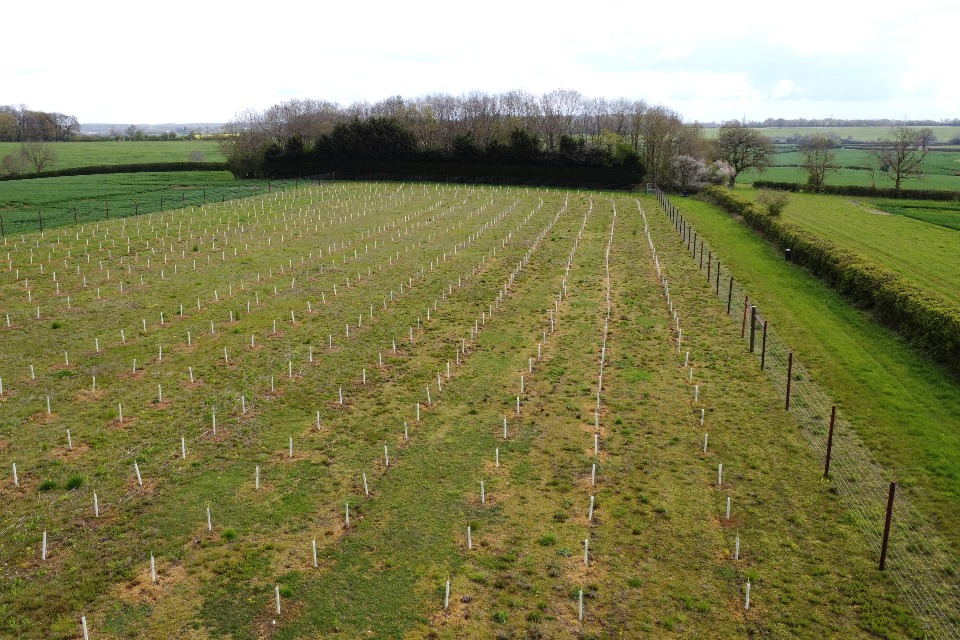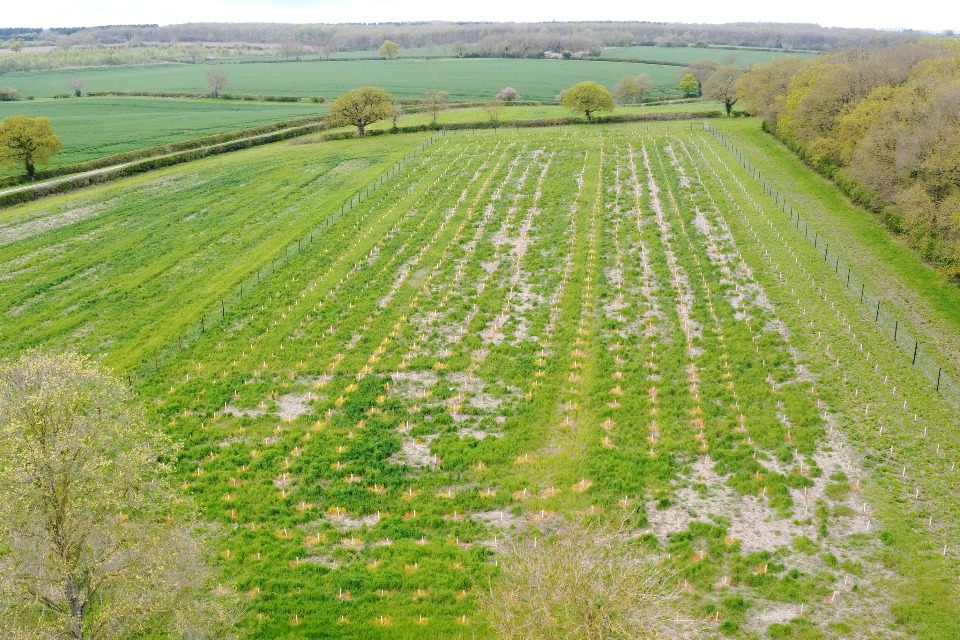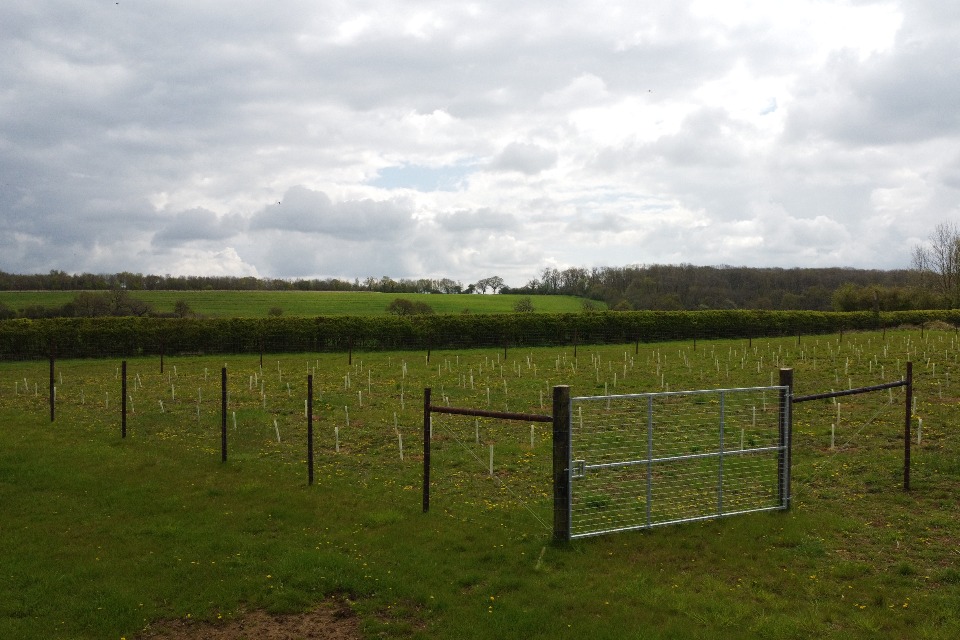Birkholme Farms, Lincolnshire
Published 8 December 2023
Continuing a legacy by planting and expanding woodland that benefits nature while enhancing the value of the family farm.
- site: Birkholme Farms, Birkholme Manor, Lincolnshire
- size: 40 hectares of woodland, expanded by 3 hectares in this latest project
- type and species mix: predominantly native broadleaf trees, including oak, wild cherry and hornbeam
- planted: winter 2022 to 2023
- grant: England Woodland Creation Offer (EWCO)
Creating a woodland that continues the family legacy
Vincent Hedley-Lewis, Owner and Tenant, Birkholme Manor:
Planting and managing woodland can benefit wildlife, improve your shoot, make you money from carbon or offset your carbon use, provide a legacy, and enhance the value of your land. There are grants available to plant, and it could really increase the value of your estate by making the farm a much nicer place to live.

Birkholme Farms. Credit: Vincent Hedley-Lewis
Birkholme Manor sits on a 453 hectare farm, 2 miles south of Colsterworth in Lincolnshire, and is home to 43 hectares of woodland with a range of different tree ages and species. The family have been planting woodland to benefit nature since 1923 and the gardens surrounding the house were laid out by the current owner’s grandmother who had a love for trees and roses, which feature prominently in the gardens design.
When Vincent took over the farm when his father passed in 1976, his objective was to enhance the value of the estate by maximising farm and estate profitability while being sensitive to the needs of the environment. In his time, Vincent has added an additional 21 hectares of woodland and recognises how the woodlands can add to the value of the family farm.
The latest project, funded under the England Woodland Creation Offer (EWCO), added 3 special plots of woodland in January 2023, totalling 3 hectares. These are named Amanda, Selena, and Melissa, after Vincent’s 3 daughters who work in London but love coming back to the farm when time allows.
Vincent Hedley-Lewis, Owner and Tenant, Birkholme Manor:
With all the grants available, the net cost of planting trees is outweighed by the increase in the value of the estate by making it a really attractive place to live. You are also enhancing the value of the farm: undoubtedly trees in the right place create natural capital, and not to mention playing your part to stem climate change through carbon sequestration and flood mitigation.

Aerial view of Melissa's spinney planting. Credit: Vincent Hedley-Lewis
Connecting woodland for nature and wildlife
For Vincent, planting woodlands has always served to enhance the value of nature and wildlife: the farm has 3 ancient woodlands covering 22 hectares, with almost 21 additional hectares planted by the family to join existing habitats and provide additional shelterbelts for wildlife corridors and shooting. Vincent hopes to increase the environmental value of the land with these 3 small woods, through connecting existing habitats.
Bird counts are carried out every year, one in springtime and one in autumn. This allows the owner to monitor data for bird species and population. Accessing funding from Environmental and Countryside Stewardship Schemes has allowed the owners to create wildflower meadows and with bird seed mixes included.
The spring count in 2023 saw a few grey partridges for the first time in years and there appeared to be many more brown hares.
A woodland that works for the business
Vincent worked as an accountant with agricultural businesses for much of his career, before moving to take over the family farm. Vincent recognised that not all the land was suitable for farming, with lots of grade 4 land containing heavy clay, limestone brash, and huge variants of soil. This presented an opportunity to endorse various environmental and woodland schemes on otherwise unproductive land, especially with the removal of Basic Payment Scheme (BPS) payments.
The existing woodland generates some income from thinning and there will continue to be shooting on the farm making the most of the woodland setting.
The new scheme has also been registered with the Woodland Carbon Code (WCC), which provides Vincent with the option to apply for the Woodland Carbon Guarantee (WCaG) and sell carbon credits to the government every 5 or 10 years up to 2055-56 for a guaranteed price that is index-linked for the life of the project contract. But Vincent has calculated that he will need all the carbon credits to offset the emissions from his farming activities.
The money Vincent has received from grants has also helped with protecting the woodlands from deer, an important consideration when planting woodland, particularly within a region that has a large population of deer.

Aerial view of planting at Selena’s spinney. Credit: Vincent Hedley-Lewis
Top Tips
- We have received incredible advice and support from the Forestry Commission. Make sure to make the most of the guidance available to you.
- Consider where you’re planting, for us it was not ideal to plant along the side of roads as they could become a hazard when they mature.
- Before selling carbon credits, consider how the carbon could be used to offset your own carbon emissions.
- Identify areas of land for trees that are not making any income on the farm.
- Don’t spare on deer fencing, it’s important to protect your young trees.
- Make sure you use a recommended contractor for thinning to ensure it’s done well.

Side view of Amanda’s Spinney planting. Credit: Vincent Hedley-Lewis
Further information
Woodland creation and information on grants and available support read the Tree planting and woodland creation: overview.
Find out how other farmers and landowners are benefitting from woodland creation, visit: Tree planting and woodland creation case studies.

